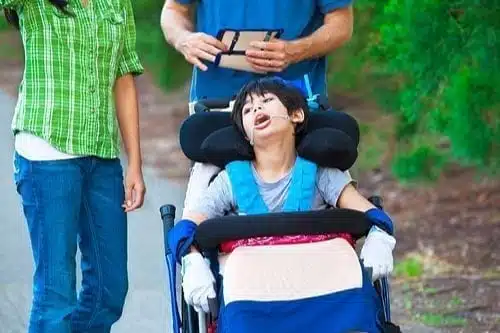
This post addresses Cerebral Palsy and SSA Disability Benefits. If you or your child have been assessed with Cerebral Palsy, read on for information on how the Social Security Administration will evaluate a claim for disability benefits.
Attorney Kimberly Bishop, of The Bishop Law Firm, is a NC Board Certified Social Security Disability Lawyer in Raleigh, NC who has practiced disability since 2009 in North Carolina. In addition, Chasity Everett, EDPNA, also represents disability clients for the firm and has worked with disabled clients since 2002, with the last 15 years with Attorney Bishop.
If you are looking for a Social Security Disability Lawyer in NC, give us a call today for a free case review, 919-615-3095 or you can start your free case review online now:
What is Cerebral Palsy?
Cerebral Palsy is one of the most common causes of chronic childhood disability. Broadly speaking, cerebral palsy impairs the ability to control body movement due to damage to the brain while in the development stage. The United Cerebral Palsy Association estimates that more than 764,000 Americans have Cerebral Palsy. Via WebMD
"Cerebral palsy is caused by an abnormality or disruption in brain development, usually before a child is born. In many cases, the exact trigger of these brain abnormalities isn't known. Factors that may lead to problems with brain development include: Random mutations in genes that control brain development; maternal infections that affect the developing fetus; fetal stroke, a disruption of blood supply to the developing brain; lack of oxygen to the brain (asphyxia) related to difficult labor or delivery (rare); infant infections that cause inflammation in or around the brain or traumatic head injury to an infant from a motor vehicle accident or fall." via Cerebral palsy Causes - Diseases and Conditions - Mayo Clinic.
Symptoms can include intellectual disability, stiff muscles, poor muscle coordination and muscle tone, heart and lung disease, issues with balance and depth perception, chronic pain, muscle spasticity and writhing movements to name a few.
Per the CDC, there are four types of Cerebral Palsy:
- Spastic cerebral palsy is the most common form of Cerebral Palsy. Increased muscle tone means stiff muscles and awkward movements. Diplegia, hemiplegia and quadriplegia describe the parts of the body affected with quadriplegia being the most severe form as it affects all limbs, the body's trunk, and face.
- Ataxic cerebral palsy affects balance and coordination. Quick movements or movements that require control (like writing) can present a challenge.
- Dyskinetic cerebral palsy involves difficulty controlling hands, arms, feet, and legs. Muscle tone can range from extreme tightness to looseness in a single day.
- Mixed cerebral palsy is, as it sounds, when a patient has symptoms of more than one type of the above.
Treatment for Cerebral Palsy can range from injections, medications, physical therapy, speech and language therapy, recreational therapy or orthopedic surgery (per Mayo Clinic).
Cerebral Palsy can range from mild to severe depending on your child's degree of limitation. Mild cerebral palsy may cause no limitations in daily life but severe Cerebral Palsy could result in being wheelchair bound with serious challenges in their daily lives.
Types of Social Security Disability Benefits
Before applying for Social Security Disability, you need to know the two (general) types of benefits that Social Security offers the disabled:
Social Security Disability Insurance (SSDI)
SSDI (Social Security Disability Insurance) is based on the credits from the work you have done in your life. You must be found disabled before your date last insured (DLI) to be found eligible for SSDI. Your DLI is calculated by counting your “quarters of coverage” from your earnings record. You must have 20 “quarters of coverage” of the last 40 quarters. Simply put, you must have worked 5 years of the last ten years (in general). In addition, Adult Disabled Children can be eligible for benefits off their parent’s account.
Supplemental Security Income (SSI)
SSI (Supplemental Security Income) is a need-based program and you must meet income/asset standards in addition to being found disabled under the five steps above. Please note that parental income affects a child's eligibility for SSI (Also read Deeming Parental Income).
In 2023, SSI is $914.00 per month for an individual and $1,371 for an eligible couple. SSI will be reduced by 1/3 if you are receiving financial help from others. In NC, SSI recipients are also entitled to Medicaid.
SSI is also available for disabled children and is evaluated under a different standard than adults. Children must have a medically determinable physical or mental impairment or impairments (including emotional or learning problems) which result in marked and severe functional limitations, and the impairment(s) has lasted or can be expected to last for a continuous period of at least 12 months or be expected to result in death. Child SSI terminates when the child turns 18. The claimant will then have to reapply and be evaluated under the above adult sequential evaluation.
Is Cerebral Palsy a disability?
A diagnosis of Cerebral Palsy alone is not enough to be found disabled. The real question is: how does your or your child's Cerebral Palsy affect their life? Every person is different, but if your or your child's Cerebral Palsy prevents them from moving about, communicating, or expressing their feelings they may be found disabled.
The Social Security Administration evaluates cerebral palsy for children under 111.07:
111.07 Cerebral palsy, characterized by disorganization of motor function in two extremities (see 111.00D1), resulting in an extreme limitation (see 111.00D2) in the ability to stand up from a seated position, balance while standing or walking, or use the upper extremities.
Adults are evaluated under 11.07:
11.07 Cerebral palsy, characterized by A, B, or C:
A. Disorganization of motor function in two extremities (see 11.00D1), resulting in an extreme limitation (see 11.00D2) in the ability to stand up from a seated position, balance while standing or walking, or use the upper extremities.
OR
B. Marked limitation (see 11.00G2) in physical functioning (see 11.00G3a), and in one of the following:
- Understanding, remembering, or applying information (see 11.00G3b(i)); or
- Interacting with others (see 11.00G3b(ii)); or
- Concentrating, persisting, or maintaining pace (see 11.00G3b(iii)); or
- Adapting or managing oneself (see 11.00G3b(iv)).
OR
C. Significant interference in communication due to speech, hearing, or visual deficit (see 11.00E2).
The two listings, despite one being for children and one for adults, are very similar. The inability to use two extremities and extreme limitation in the ability to move around is mentioned in both. But what is an extreme limitation? In simplest terms, an extreme limitation would require a Cerebral Palsy patient to need assistance when trying to stand, walk or use their hands.
Listing 11.07 also discusses marked limitations physically and one accompanying mental symptom. If you are unable to use information, interact with others, concentrate, or manage yourself, work is not an option for you.
Lastly, inability to communicate, hear or see would definitely eliminate competitive employment. I advise my clients not to worry about meeting a listing. Most listings are very hard to meet.
If your child has been diagnosed with cerebral palsy and they are having symptoms, file a claim for disability benefits as soon as possible for them. Your child may be eligible to receive expedited payments if there is an allegation of cerebral palsy and they have marked difficulty in walking (for example the use of braces), speaking or coordination of the hands or arms (read more at Presumptive Disability Payments).
Adults and children with Cerebral Palsy may be able to find help on the state level through plans like we have in North Carolina, Community Alternative Program for Disabled Adults (CAP/DA) or the Community Alternatives Program for Children (Cap/C). You should check in your state to see what programs are available.
There is also support for cerebral palsy patients and their families, visit CerebralPalsy.org for more information. You may also want to speak to a birth injury attorney who may be able to help you with a possible medical malpractice claim (Reiter and Walsh, P.C. handles birth brain injury cases nationwide and offers helpful information on their site).
The Bishop Law Firm represents Social Security Disability clients in Raleigh, Durham, Fayetteville, Cary, Rocky Mount, Wilson, Smithfield, Louisburg, Chapel Hill, Roanoke Rapids , Winston Salem, Garner, Greensboro, Greenville and surrounding areas in North Carolina. Call us today for a free case review, (919) 615-3095 or start now.
Also read NC Social Security Disability Lawyer

